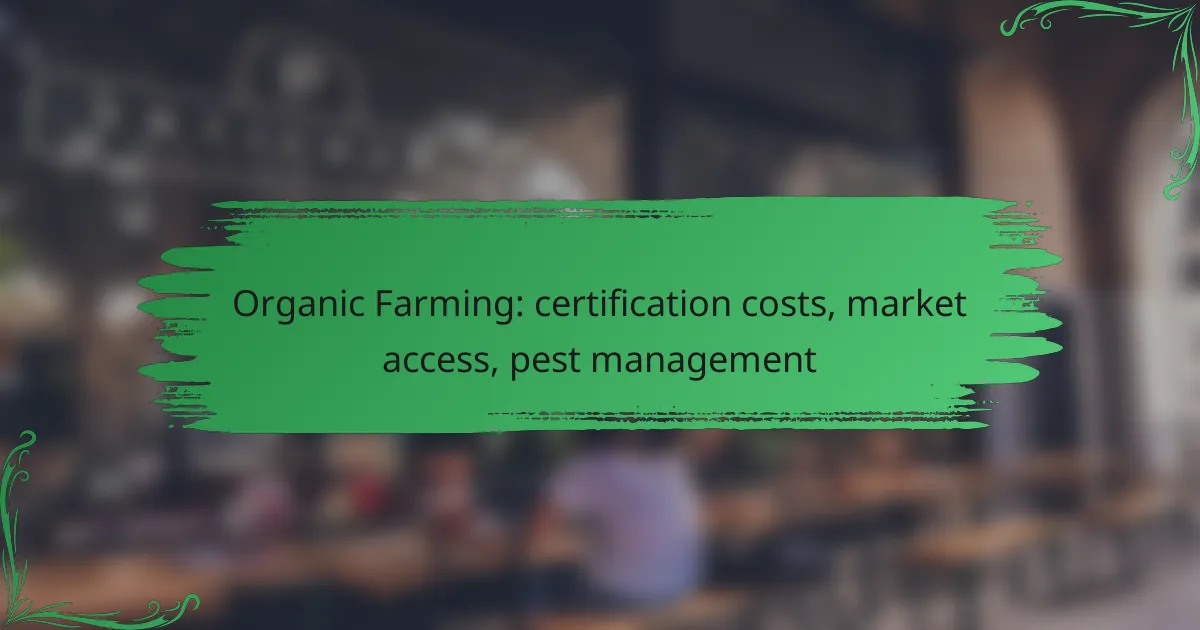Vertical farming presents a unique opportunity for sustainable agriculture, but it comes with high startup costs and significant energy consumption challenges. Successful ventures must navigate the complexities of financial planning and resource optimization while managing the demands of lighting, temperature control, and water usage. Additionally, a solid foundation in technical expertise, including hydroponics and automation, is crucial for maximizing efficiency and productivity in this innovative farming approach.
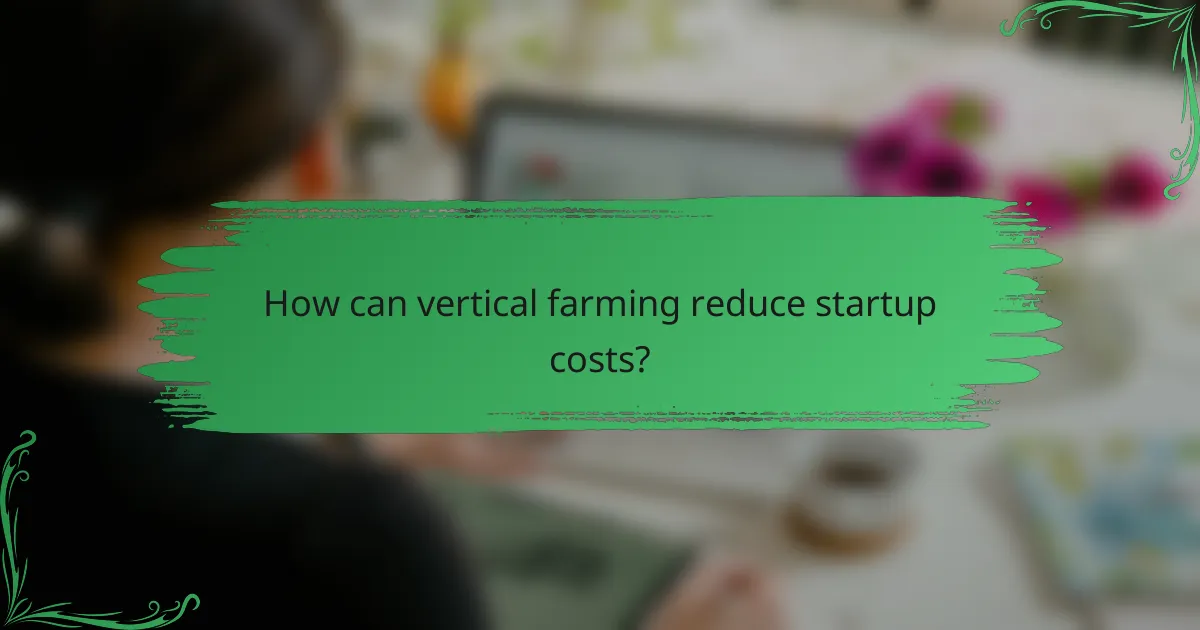
How can vertical farming reduce startup costs?
Vertical farming can reduce startup costs through strategic planning and resource optimization. By leveraging available financial support and innovative technologies, new ventures can minimize initial investments and operational expenses.
Utilizing government grants
Many governments offer grants and subsidies to support sustainable agriculture initiatives, including vertical farming. These financial aids can significantly lower the initial capital required to start a farm, allowing entrepreneurs to focus on technology and infrastructure.
Research local and national programs that provide funding for agricultural innovation. For example, in the United States, the USDA has various grant programs aimed at promoting sustainable farming practices.
Implementing modular systems
Modular systems allow vertical farms to scale operations gradually, reducing upfront costs. By starting with a smaller, modular setup, farmers can expand as demand grows without the need for large initial investments.
Consider using pre-fabricated units that can be easily assembled and expanded. This approach not only saves on construction costs but also allows for flexibility in adapting to market changes.
Partnering with local universities
Collaborating with local universities can provide access to research, technical expertise, and potential funding sources. Many institutions have programs focused on agricultural technology and sustainability, which can be beneficial for vertical farming startups.
Engage with university extension services or agricultural departments to explore partnership opportunities. These collaborations can lead to shared resources, reduced costs, and innovative solutions tailored to local conditions.
Adopting shared facilities
Shared facilities, or incubators, allow multiple startups to utilize the same space and resources, significantly lowering individual costs. By sharing equipment and infrastructure, vertical farms can reduce their financial burden while benefiting from a collaborative environment.
Look for local agricultural incubators or co-working spaces that cater to food production. This model not only cuts costs but also fosters networking and knowledge sharing among entrepreneurs in the industry.
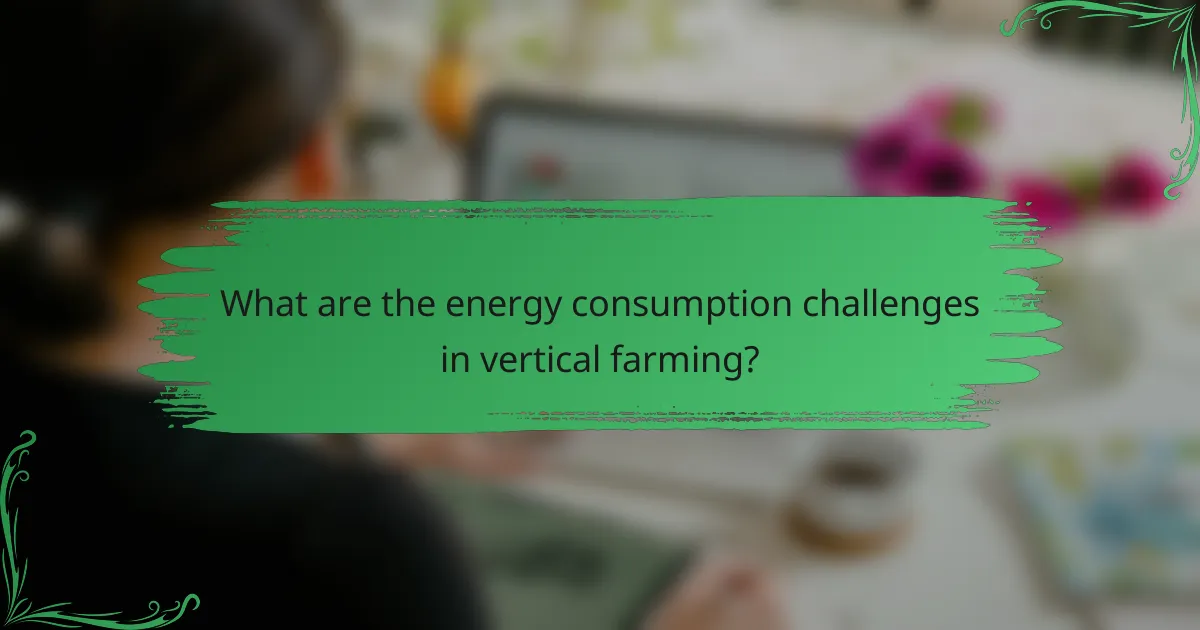
What are the energy consumption challenges in vertical farming?
Energy consumption in vertical farming presents significant challenges, primarily due to high lighting demands, temperature control needs, and water usage. These factors can lead to increased operational costs and require careful management to ensure sustainability and profitability.
High lighting energy demands
Vertical farms rely heavily on artificial lighting to promote plant growth, often using LED systems that consume substantial energy. The energy costs associated with lighting can account for a large portion of the total operational expenses, sometimes reaching up to 30-50% of the overall energy consumption.
To mitigate these costs, farmers can optimize light schedules and select energy-efficient lighting technologies. For instance, using full-spectrum LEDs can enhance photosynthesis while reducing energy use compared to traditional lighting systems.
Temperature control requirements
Maintaining optimal temperatures in vertical farms is crucial for plant health and growth, which necessitates significant energy for heating and cooling systems. Depending on the climate, energy consumption for climate control can vary widely, with some facilities using up to 40% of their energy for this purpose.
Implementing energy-efficient HVAC systems and utilizing thermal mass can help reduce energy usage. Additionally, integrating smart sensors to monitor and adjust temperature in real-time can further optimize energy consumption.
Water usage and recycling
Vertical farming systems often employ hydroponics or aeroponics, which can lead to lower water usage compared to traditional farming. However, the energy required for water circulation and filtration can still be significant, contributing to overall energy demands.
To enhance sustainability, farms should consider implementing water recycling systems that minimize waste and reduce energy consumption associated with water treatment. Regular maintenance of these systems is essential to ensure efficiency and prevent energy loss.

What technical expertise is needed for vertical farming?
Vertical farming requires a blend of technical expertise in areas such as hydroponics, automation technologies, and plant biology. Understanding these fields is essential for optimizing growth conditions and ensuring efficient operations in a controlled environment.
Knowledge of hydroponics
Hydroponics is a method of growing plants without soil, using nutrient-rich water instead. Familiarity with different hydroponic systems, such as nutrient film technique (NFT) or deep water culture (DWC), is crucial for selecting the right approach based on the crops being cultivated.
Understanding the nutrient requirements and pH levels for various plants can significantly impact growth rates and yields. Regular monitoring and adjustments are necessary to maintain optimal conditions, which can be achieved through automated systems or manual checks.
Experience with automation technologies
Automation technologies play a vital role in vertical farming by enhancing efficiency and reducing labor costs. Familiarity with sensors, climate control systems, and automated irrigation can help maintain ideal growing conditions.
Implementing automation can also aid in data collection and analysis, allowing farmers to make informed decisions based on real-time information. Knowledge of software platforms that integrate these technologies is beneficial for streamlining operations and improving productivity.
Understanding of plant biology
A solid grasp of plant biology is essential for maximizing crop health and productivity in vertical farming. This includes knowledge of plant physiology, growth cycles, and pest management strategies.
Understanding how different environmental factors, such as light, temperature, and humidity, affect plant growth can help in creating optimal conditions. Additionally, being aware of common diseases and pests allows for proactive measures to protect crops, ensuring a successful harvest.

How to choose the right technology for vertical farming?
Choosing the right technology for vertical farming involves evaluating various components that impact efficiency and productivity. Key areas to consider include LED lighting, climate control systems, and hydroponic systems, each of which plays a crucial role in the overall success of your farm.
Evaluating LED lighting options
LED lighting is essential for plant growth in vertical farming, as it mimics natural sunlight and can be tailored to specific plant needs. When evaluating options, consider factors such as energy efficiency, spectrum range, and lifespan. Look for lights that offer adjustable spectrums to optimize growth stages, which can lead to better yields.
Common choices include full-spectrum LEDs and those specifically designed for vegetative or flowering phases. Prices can vary widely, typically ranging from a few hundred to several thousand dollars depending on the scale and technology.
Assessing climate control systems
Climate control systems are vital for maintaining optimal growing conditions in vertical farms. These systems regulate temperature, humidity, and air circulation, influencing plant health and growth rates. When assessing options, consider the integration of sensors and automation for real-time monitoring and adjustments.
Investing in a robust climate control system can be costly, often starting in the low thousands of dollars. However, the benefits of improved crop quality and reduced energy costs can justify the initial investment over time.
Comparing hydroponic systems
Hydroponic systems are crucial for delivering nutrients directly to plants in a soil-less environment. There are several types, including nutrient film technique (NFT), deep water culture (DWC), and aeroponics, each with unique advantages and challenges. For instance, NFT systems are efficient in water usage but require precise monitoring, while DWC systems are easier to manage but may need more space.
When comparing systems, consider factors such as startup costs, maintenance requirements, and scalability. Prices can range from a few hundred to several thousand dollars, depending on the complexity and size of the system. Choose a system that aligns with your budget and long-term farming goals.
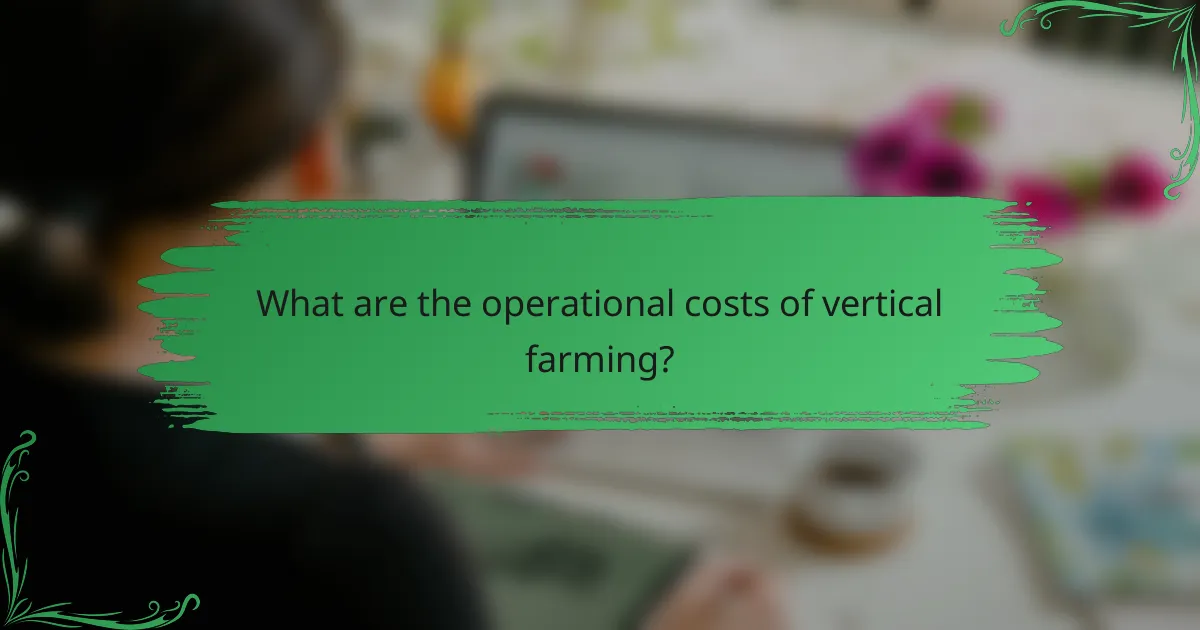
What are the operational costs of vertical farming?
The operational costs of vertical farming can be significant, primarily due to high startup expenses, ongoing energy consumption, and the need for specialized technical expertise. Understanding these costs is crucial for anyone considering entering this innovative agricultural sector.
Labor expenses
Labor expenses in vertical farming can vary widely based on the scale of the operation and the level of automation employed. Typically, skilled labor is required for tasks such as monitoring plant health, managing systems, and conducting maintenance, which can lead to higher wage costs compared to traditional farming.
Employing automation technologies can help reduce labor costs over time, but initial investments in these systems can be substantial. It’s essential to balance the cost of labor with the potential efficiencies gained through automation.
Maintenance of equipment
Maintenance of equipment is a critical aspect of vertical farming that directly impacts operational costs. Regular upkeep of systems such as lighting, irrigation, and climate control is necessary to ensure optimal performance and crop yield.
Budgeting for maintenance should include both routine checks and potential repairs. Setting aside a percentage of the initial equipment cost for ongoing maintenance can help prevent unexpected expenses that could disrupt operations.
Utility costs
Utility costs, particularly for electricity and water, are among the highest operational expenses in vertical farming. The energy required for lighting, heating, and cooling can lead to monthly bills that are significantly higher than those for traditional farming methods.
To manage utility costs, consider implementing energy-efficient technologies, such as LED lighting and smart climate control systems. Additionally, exploring renewable energy options, like solar panels, can help mitigate long-term utility expenses and improve sustainability.
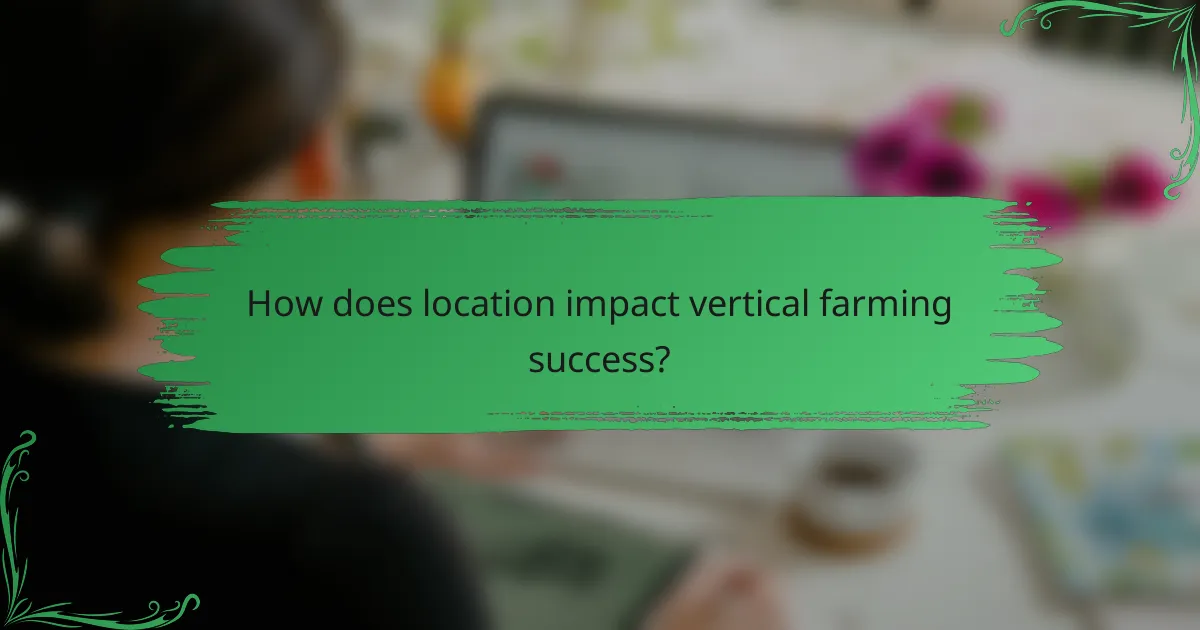
How does location impact vertical farming success?
Location significantly influences the success of vertical farming by determining access to markets, resources, and energy costs. Urban areas often provide a more favorable environment due to proximity to consumers and lower transportation expenses.
Proximity to urban markets
Being close to urban markets is crucial for vertical farming operations, as it reduces transportation costs and ensures fresher produce. Urban centers typically have higher demand for locally sourced food, which can lead to better profit margins.
Vertical farms situated near cities can capitalize on the trend of consumers seeking fresh, organic produce. This proximity allows farmers to deliver products quickly, often within hours of harvest, enhancing product quality and customer satisfaction.
To maximize success, vertical farmers should research local market trends and consumer preferences. Engaging with local restaurants, grocery stores, and farmers’ markets can create valuable partnerships and increase sales opportunities.



